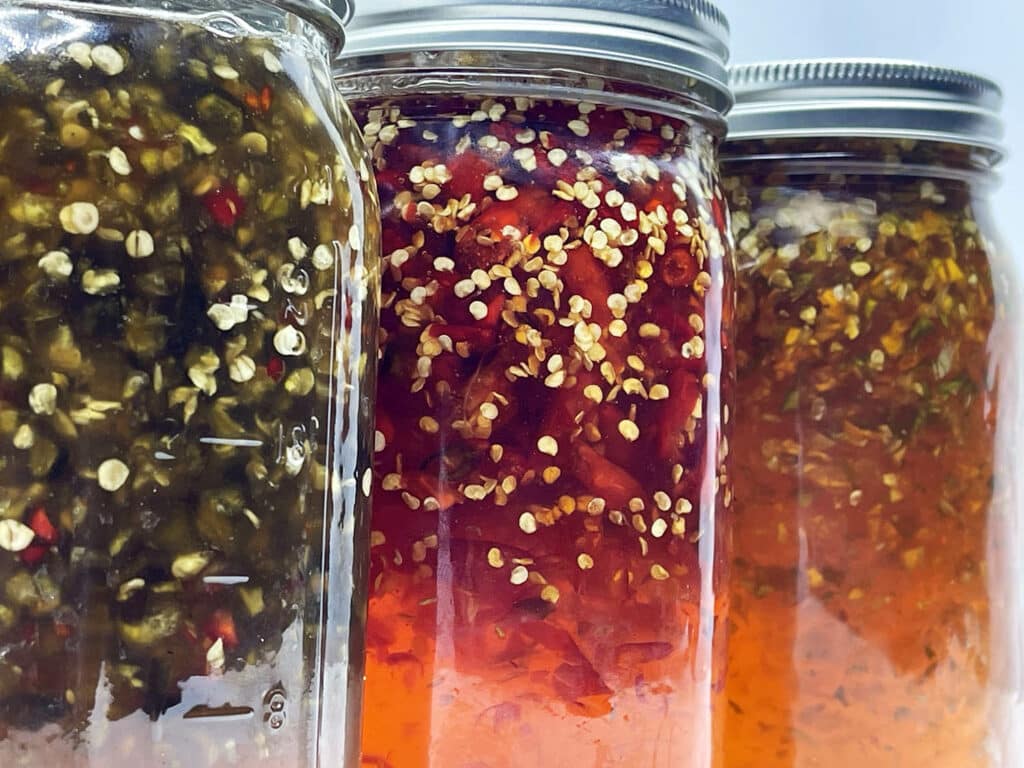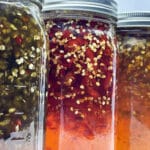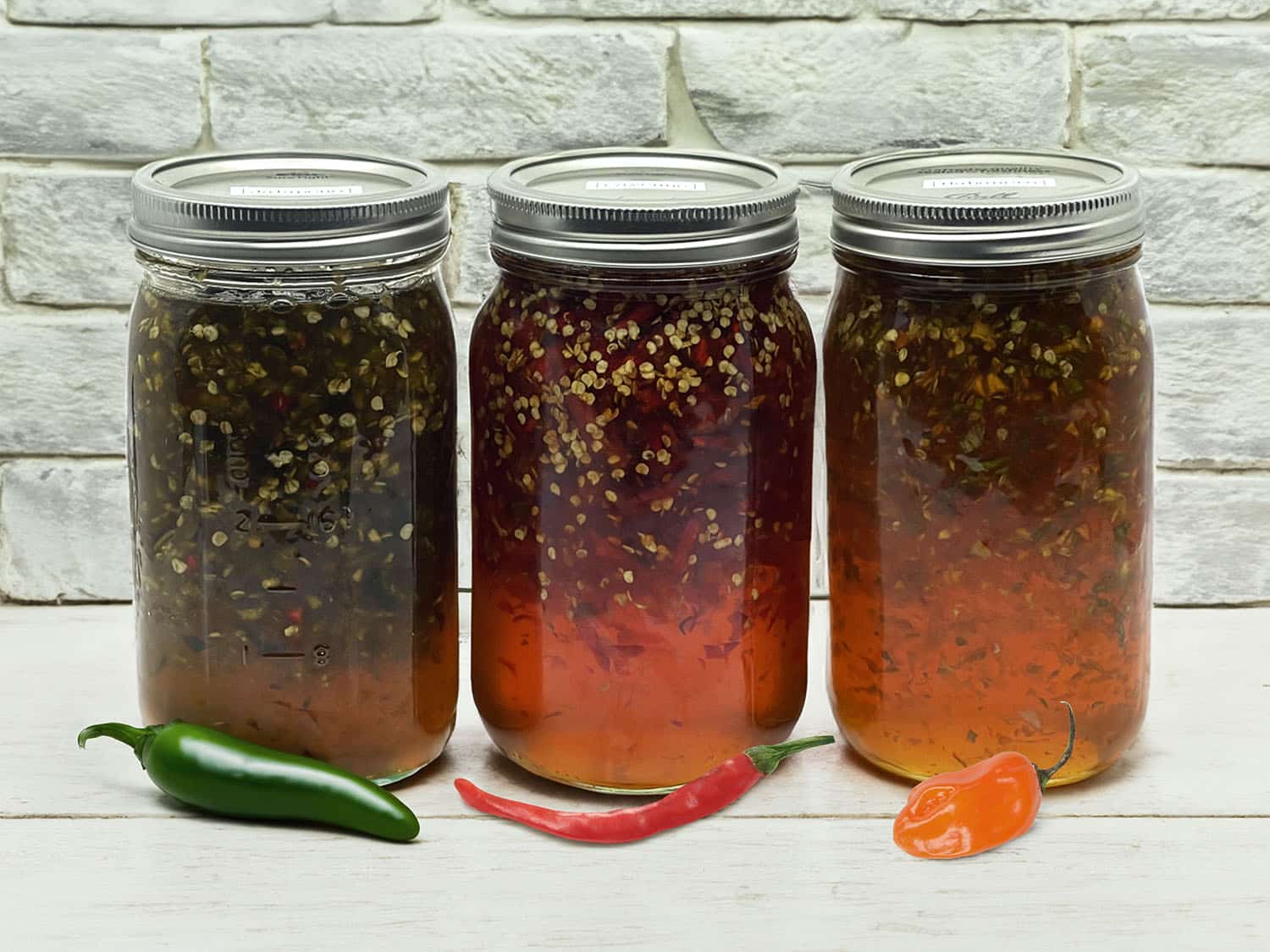Hot honey is one of those culinary wonders that is just as home in the medicine cabinet as it is in the kitchen.
Melding the sweetness of honey with the spicy heat of peppers, fermented hot honey creates a unique and complex, yet well-balanced flavor profile. The result is a glorious spicy ambrosia that has countless culinary and medicinal uses!
How do you ferment honey?
You’re probably familiar with mead, a fermented alcoholic beverage made from honey, water and sometimes fruit, herbs and spices. The concept behind hot honey is similar, but without the extra water.
Honey is hygroscopic, meaning it has a strong affinity for water and readily attracts and absorbs moisture from its surroundings. The high concentration of sugars in honey (roughly 80%) creates an osmotic environment. Osmotic pressure is the force exerted by the movement of water molecules from an area of lower solute concentration (outside the honey) to an area of higher solute concentration (inside the honey). The osmosis continues until the concentration of solutes on both sides is equalized.
When honey comes into contact with microorganisms such as bacteria, yeasts and molds, the honey draws water out of the cells of these microorganisms. The resulting dehydration disrupts the cellular structure and metabolic processes of the microbes, ultimately hindering their growth.
Honey on its own naturally has a pretty low water content — somewhere in the range of 15% to 19% — or just under what is required to allow fermentation to happen (typically 20% and above).
Fresh peppers naturally contain a high moisture content (around 90% water). When chopped and blended with honey, their moisture is quickly drawn out by the hygroscopic honey. The addition of fresh peppers introduces *just* enough water to bump the overall moisture content north of 20%. This self-dilution combined with the wild yeasts and microbial activity introduced by the peppers (and present in the environment) makes it an ideal pairing for kickstarting fermentation.
While mead fermentation generally takes several weeks to months (or even years if you include time for aging), fermenting hot honey is a much shorter process. We’re not focused on achieving high alcohol content here (although small amounts of alcohol may be produced as of a byproduct of fermentation) so hot honey only ferments for a few days up to a couple of weeks.
As with mead, the fermentation time for hot honey can be adjusted based on the desired outcome. A shorter fermentation will result in a brighter, fresher taste, while a longer fermentation will produce more complex flavors (as well as a smidge more alcohol content).
Is hot honey shelf stable?
Raw, unprocessed, unfiltered honey has a virtually unlimited shelf-life, but do the added peppers (and their accompanying moisture content) change the math?
Short answer: Fermented honey should not spoil, assuming certain conditions are met.
As mentioned above, honey naturally contains a high concentration of sugars, which create an osmotic environment that inhibits the growth of most microorganisms — including spoilage-causing bacteria and yeasts. Even with added moisture from ingredients like hot peppers, the overall sugar content remains relatively high, helping to preserve the mixture.
Honey is also naturally acidic with a pH level around 3.9, which further inhibits the growth of many microorganisms. Hot peppers are also quite acidic. Depending on the types of wild bacteria and yeast captured by the hot honey ferment, the fermentation process can also lead to increased acidity. Lactic acid bacteria (common in the fermentation of foods like sauerkraut and yogurt) convert sugars into lactic acid, which lowers the hot honey’s pH. Yeast fermentation can also contribute to acidity, though the impact on pH may not be as pronounced as with lactic acid bacteria.
The conversion of sugars into alcohol (ethanol), carbon dioxide and other byproducts by fermenting microorganisms can also assist in creating an environment less hospitable to spoilage microorganisms.
Of course, proper sanitation, handling and storage practices are essential to prevent contamination. Using clean equipment and sealing containers tightly will help maintain your hot honey’s integrity and prolong its shelf life.

Medicinal applications
Even if you’re not a particular fan of spicy food, I would argue that a jar of hot honey should still have a place in your medicine cabinet.
Capsaicin, the primary medicinal constituent in hot peppers, is probably best known for its analgesic (pain-relieving) properties. If you’ve ever chopped a bunch of hot peppers without using gloves, you know what I’m talking about! It’ll numb your fingers (and any other body parts you touched) for hours.
Thanks to its ability to deplete substance P, a neurotransmitter responsible for transmitting pain signals, topical capsaicin is commonly used in pain management, such as in creams or salves for minor conditions like joint pain and muscle soreness.
Capsaicin also exhibits anti-inflammatory effect, and may help reduce inflammation and swelling. It can be used to manage inflammatory conditions such as arthritis.
Both raw honey and hot peppers contain compounds that support the immune system. Honey is a well documented antimicrobial, while the vitamin C in hot peppers (as much as twice the amount found in an equivalent portion of citrus) can help boost immunity and provide extra antioxidant support, helping to combat free radicals and oxidative stress in the body. This is why they’re both traditional ingredients in fire cider!
The combination of honey and hot peppers can provide relief for sore throats and coughs. Honey is a natural expectorant and has soothing and antimicrobial properties while the spiciness of hot peppers (again, that capsaicin) can provide a warming, numbing sensation in the throat.
Capsaicin can temporarily relieve nasal congestion by thinning mucus and opening nasal passages. Hot honey may be useful in herbal remedies for respiratory conditions like sinusitis or allergies. Capsaicin is sometimes incorporated (very sparingly!) into nasal sprays for its decongestant effects.
Honey is traditionally known for its digestive benefits and hot peppers (in moderation) can stimulate digestion. Hot honey may be useful to soothe digestive discomfort or as a remedy for mild indigestion. Bonus: capsaicin has also been associated with increased metabolism and a temporary rise in energy expenditure!
Capsaicin may have cardiovascular benefits, including improving blood circulation, reducing blood pressure and regulating cholesterol levels.
Some research indicates that capsaicin may even have anti-cancer properties, inhibiting the growth of certain cancer cells and inducing apoptosis (programmed cell death).
Culinary applications
In the kitchen, hot honey is a versatile condiment that adds a sweet and spicy kick to a wide range of dishes!
- Delicious stirred into tea or coffee for a sweet-n-spicy twist.
- Makes an excellent glaze for grilled meats, vegetables or seafood. It can also be used as a marinade (or ingredient in a marinade) to infuse dishes with a sweet and spicy flavor.
- Drizzle hot honey (as well as the fermented hot peppers) on pizza for a sweet and spicy contrast that pairs wonderfully with cheesy and savory pizza toppings!
- Mix with vinegar, olive oil and other seasonings to create a flavorful and unique salad dressing.
- Use it to create unique sauces and dips for chicken wings, chicken tenders — or as a dipping sauce for spring rolls or dumplings.
- Hot honeys are your secret ingredient for making spicy cocktails and mocktails and a quick way to make a spicy margarita or Bloody Mary.
- Lovely paired with soft cheeses like goat cheese or burrata. The creaminess balances the sweet heat perfectly.
- Spread on breads, biscuits and cornbread instead of jam or butter.
- Drizzle over ice cream, pancakes, waffles or fruit for a spicy-sweet treat.

Fermented Hot Honey
5 Stars 4 Stars 3 Stars 2 Stars 1 Star
No reviews
Ingredients
fresh hot peppers (cayenne, jalapeños, habaneros, Thai chiles, etc.), finely chopped/minced
raw, unfiltered honey (preferably local)
mason jar
Instructions
- Fill a pint (or quart) sized mason jar about 1/2 full of chopped hot peppers such as cayenne, jalapeños, habaneros or Thai chiles. You can chop them by hand or pulse them in the food processor; a mechanical hand chopper tool works well too! There is no need to remove the seeds.
- Cover with honey until jar is full and the peppers are fully submerged. If honey is too solid to pour, gently heat it by placing it in a warm water bath. Take care not to heat the honey beyond about 110F, or you risk destroying its beneficial enzymes and microbes.
- Secure the jar’s lid, and place in a sunny windowsill to ferment. It’s not a bad idea to place it on a plate *just in case* the ferment gets overly enthusiastic. I’ve only had this happen with hot honey once, but every so often, a ferment will try to escape its jar.
- Flip the jar onto its lid once a day or so. This ensures that the hot peppers stay submerged under the honey. You do not want them exposed to any oxygen or you risk contamination and bacteria growth.
- Ferment for 2-3 weeks, allowing plenty of time for the flavor to extract into the honey and the microbes to work their magic.
- When the time is up, use a fine mesh strainer to strain out the peppers. The honey will now be a bit thinner, thanks to the infused pepper juices.
- Transfer to a clean glass jar with an airtight lid. Your fermented honey is shelf stable, but storing in a cool location out of direct sunlight will maximize its lifespan. ♥


